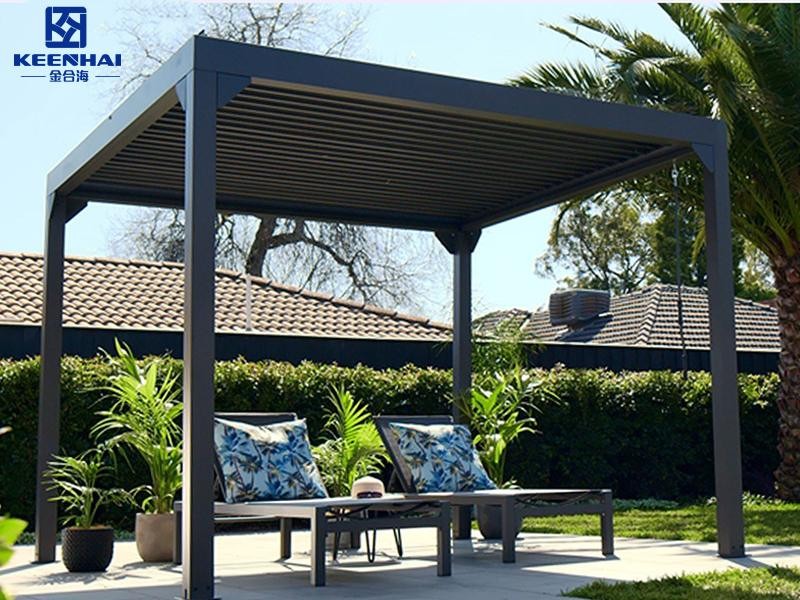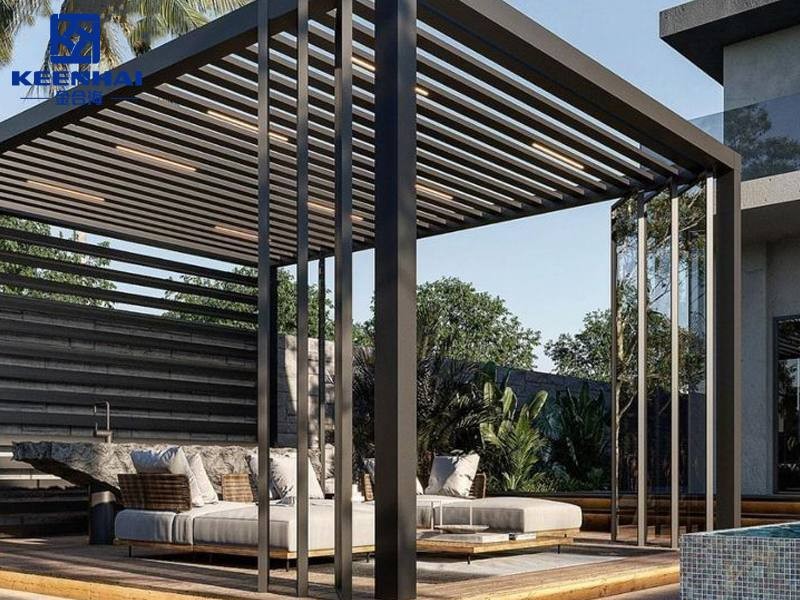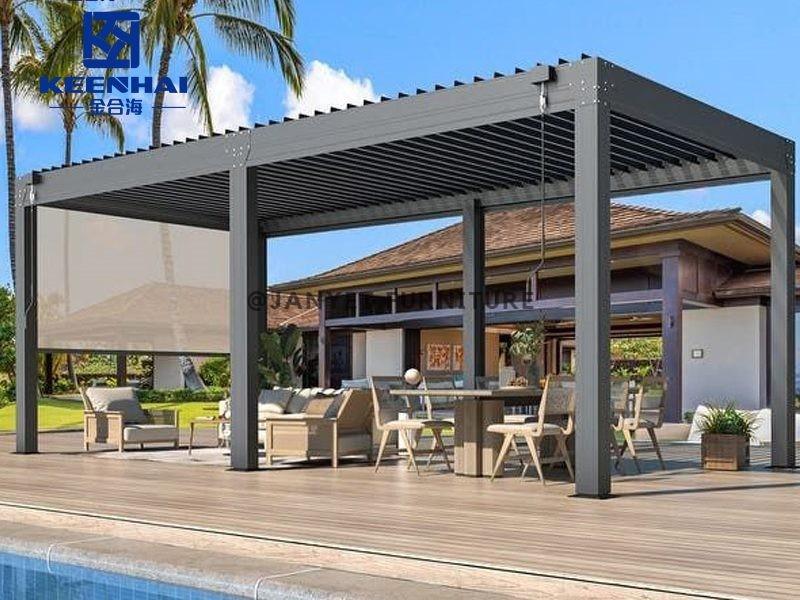
1.Material Composition and Strength
1.1Aluminum Frame Characteristics
The Aluminum louvered roof gazebo is typically built from 6063-T5 or 6061-T6 architectural-grade aluminum, the same alloy used in curtain walls and structural beams. This material has a density of around 2.7 g/cm³, roughly one-third the weight of steel, making it easy to transport and assemble even for large backyard projects or rooftop decks.
High-end aluminum pergolas can handle a snow load capacity of 150–200 kg/m², depending on beam thickness and span distance. The surface naturally forms a protective oxide layer that prevents corrosion, allowing the structure to last 20–30 years with minimal upkeep. In humid or coastal locations, powder-coated finishes offer an added layer of UV and salt protection, helping the frame retain its color for a decade or more.
Designers prefer aluminum because it’s dimensionally stable, meaning it doesn’t expand or shrink with temperature swings. That stability makes it perfect for modular assembly and for integrating lighting or motorized louver systems without affecting strength or alignment.
1.2Wood Frame Characteristics
Wood pergolas are traditionally built from cedar, redwood, or pressure-treated pine. Cedar has a compressive strength around 4,500 psi, while redwood averages 6,000 psi — strong enough for residential pergolas but less stable than aluminum when exposed to moisture or heat. Wood’s density ranges between 0.6–0.9 g/cm³, and because it’s porous, it tends to absorb and release moisture, leading to warping or surface cracks over time.
In backyard settings, a wood pergola delivers a warm, organic look that many homeowners love for natural landscaping or rustic patios. But keeping it in shape requires effort — sanding and resealing every 12–18 months to block UV damage and prevent rot. Even high-quality cedar can fade up to 30% in color within two years under direct sunlight without protection.
Contractors often use galvanized brackets and termite-resistant treatments, especially for outdoor kitchens or poolside setups. These measures add cost and labor time, and despite them, wood remains more vulnerable to termites and humidity shifts than its aluminum counterpart.
1.3Comparative Strength and Durability
When comparing overall strength and durability, aluminum consistently outperforms wood. Aluminum retains over 90% of its tensile strength after 20 years, while wood can lose 25–35% due to environmental wear. The table below illustrates the main material differences clearly:
| Property | Aluminum Pergola | Wood Pergola |
|---|---|---|
| Density | 2.7 g/cm³ | 0.6–0.9 g/cm³ |
| Average Lifespan | 20–30 years | 10–15 years |
| Load Capacity | 150–200 kg/m² | 80–120 kg/m² |
| Maintenance Frequency | Every 2–3 years | Every 1–1.5 years |
| Fire Resistance | Non-combustible | Combustible |
| Weather Impact | Minimal | Expansion and cracking |
An Louvres Pergola made with extruded aluminum can integrate motorized louvers, LED strips, and rain sensors without structural compromise. This adaptability isn’t achievable with traditional wood beams, which can warp or twist under humidity. In tropical regions, an Aluminum pergola house can maintain structural integrity and surface finish even when daily temperatures fluctuate between 10°C and 45°C, making it a long-term investment for modern architecture and outdoor living spaces.

2.1Modern vs Classic Aesthetics
When comparing aluminum pergolas and wood pergolas, the visual contrast is immediately noticeable. Aluminum pergolas typically feature sleek lines, clean edges, and a minimalist form, making them ideal for modern or contemporary outdoor spaces such as urban patios or luxury hotel courtyards. In contrast, wood pergolas evoke a warm, traditional feel, often used in rustic gardens or Mediterranean-style homes.
In architectural projects, designers often select aluminum pergolas for commercial areas due to their ability to complement glass façades and metal cladding. For instance, an Aluminum louvered roof gazebo installed beside a pool creates a premium resort look, balancing functionality with high-end aesthetics. Wooden structures, while beautiful, often develop uneven textures or color fading after 3–5 years, especially in humid or coastal climates.
| Feature | Aluminum Pergola | Wood Pergola |
|---|---|---|
| Design Style | Modern, minimalist | Classic, natural |
| Color Stability | 95% retention after 5 years | Fades within 2–3 years |
| Ideal Use | Villas, resorts, patios | Gardens, cottages |
| Structural Precision | CNC-cut accuracy within ±0.2 mm | Manual cut variations up to ±2 mm |
Architectural studies in 2024 by the Outdoor Structure Institute show that 82% of homeowners prefer modern aluminum pergolas for their clean symmetry and low maintenance compared to wooden alternatives that require annual re-staining.
2.2Customization Possibilities
Customization is where aluminum pergolas outshine wood. Aluminum structures can be CNC-machined to exact measurements, ensuring millimeter-level accuracy for complex designs like integrated lighting, retractable louvers, or built-in gutter systems. For example, Louvres Pergola systems offer motorized roof control with precision movement under 1 second per panel adjustment, which is impossible to achieve with wooden beams.
When designing a bespoke aluminum pergola, the customization process often includes these steps:
-
Initial measurement and 3D modeling — CAD blueprints ensure the structure fits seamlessly into any architectural layout.
-
Selection of frame thickness and louver type — most residential projects use 2.0–2.5 mm thick aluminum beams, while commercial projects adopt 3.0 mm for structural rigidity.
-
Integration of accessories — LED strips, motion sensors, or solar-powered systems can be pre-installed during fabrication.
Wood pergolas, on the other hand, are limited by grain direction and wood density, which restrict the designer’s ability to create sharp angles or hidden wiring systems. Aluminum offers over 20 finish colors, from matte black to champagne silver, whereas wood is typically restricted to stains and varnishes that require renewal every few years.
2.3Color and Finish Availability
Aluminum pergolas offer a broader and more durable finish range compared to wood. With powder coating technology rated at 60–80 microns of thickness, aluminum surfaces can resist UV fading for up to 10 years, maintaining over 90% gloss retention. Options include matte, satin, metallic, or even timber-grain finishes that visually mimic real wood but require no sanding or varnishing.
In comparison, wooden pergolas rely on stains or paints that typically last 2–3 years before peeling, especially in high humidity or heavy rainfall regions. Owners often spend an average of $300–$600 annually on refinishing a medium-sized 10x12 ft structure.
| Finish Type | Average Lifespan | Maintenance Cost (per year) | UV Resistance |
|---|---|---|---|
| Aluminum Powder Coat | 8–10 years | $0–$50 | Excellent |
| Anodized Aluminum | 10–15 years | Minimal | Excellent |
| Painted Wood | 2–3 years | $300–$600 | Poor |
| Stained Wood | 3–4 years | $250–$500 | Fair |
Architects designing minimalist homes often pair Aluminum pergola house installations with anodized finishes to achieve a reflective, durable surface that complements large glass doors and concrete patios. The visual uniformity and color precision of aluminum coatings exceed 95% consistency, something traditional wood simply cannot replicate.

3.1Aluminum Maintenance Requirements
Aluminum pergolas are designed for homeowners who want style without the upkeep. The material doesn’t rust, peel, or attract termites, which makes it a low-maintenance option for both residential and commercial settings. A typical cleaning schedule only involves washing the frame with mild soap and water every 3–6 months to remove dust or salt buildup.
For outdoor spaces near the coast, like pool decks or beachfront villas, it’s recommended to rinse the structure more frequently due to salt exposure. In a 2024 durability study from the Outdoor Living Association, aluminum-coated surfaces maintained over 90% color gloss even after 8 years of UV exposure. Powder-coated finishes resist scratches up to 3H on the hardness scale, and the surface doesn’t oxidize even when exposed to 1000 hours of salt spray testing.
When integrated with modern systems like Aluminum louvered roof gazebo designs, these structures often include hidden drainage channels and sealed joints that prevent water stains or corrosion. The internal louvers only need lubrication once a year using silicone spray — no sanding or painting required, unlike traditional pergolas.
3.2Wood Maintenance Requirements
Wood pergolas look charming, but they demand constant attention. Because wood is an organic material, it reacts to moisture, sunlight, and temperature changes. To keep its appearance intact, owners must sand and re-stain or repaint every 12–18 months, depending on local climate conditions. In humid or tropical zones, neglecting maintenance for even one season can lead to mold and surface cracking.
A cedar or pine pergola that’s left untreated can lose 30% of its surface integrity within 5 years, especially in regions with annual rainfall above 1,200 mm. Maintenance also involves checking for rot, termite tunnels, and loose joints every six months. Many homeowners spend $400–$800 per year just to keep a medium-sized structure in acceptable condition.
Wood’s natural fiber absorbs water and expands, causing joints to loosen or beams to twist. For long-term outdoor use, professional contractors recommend pressure-treated lumber or hardwoods like teak, but even then, surface protection is necessary. Over time, sunlight will bleach the tone, and coatings will fade unevenly — which is why aluminum remains the favored option for modern builds.
3.3Lifespan ComparisonWhen comparing lifespan, aluminum pergolas clearly outperform wood in every measurable way. An average aluminum pergola house can last 25–35 years with minimal care, while wooden ones typically reach 10–15 years before major restoration or replacement becomes necessary.
| Material Type | Average Lifespan | Annual Maintenance Cost | Structural Warranty |
|---|---|---|---|
| Aluminum Pergola | 25–35 years | $20–$80 | Up to 15 years |
| Wood Pergola | 10–15 years | $400–$800 | 1–3 years |
The difference becomes even more noticeable in harsh weather zones. Aluminum frames remain dimensionally stable under extreme heat or cold (–20°C to 50°C), whereas wooden beams can warp or split due to moisture imbalance.
Architectural firms that specialize in long-term outdoor structures often cite aluminum pergolas as “a lifetime solution with predictable performance.” For clients seeking a premium appearance with zero stress about decay or insect damage, aluminum is a smarter and more sustainable investment.

4.Cost and Value Considerations
4.1Initial Purchase and Installation Costs
The initial investment between an aluminum and wood pergola can vary widely depending on size, finish, and design complexity. On average, an aluminum pergola costs $65–$120 per square foot, including structure and standard motorized louvers, while a traditional cedar or pine wood pergola typically ranges from $45–$85 per square foot.
Labor also plays a big role in total installation cost. Aluminum models are prefabricated and modular, allowing crews to complete installation in 6–10 hours for a 10x12 ft structure. In contrast, wood pergolas often require on-site cutting, sanding, and finishing, stretching the timeline to 2–3 full days.
For example, a homeowner in California installing a custom Louvres Pergola with integrated lighting and drainage can expect a total project budget between $6,500–$9,800, while a similarly sized cedar version averages $5,200–$7,000, excluding annual staining and weatherproofing. The upfront cost of aluminum may seem higher, but it includes built-in corrosion resistance and a maintenance-free coating that lasts over a decade.
4.2Long-Term Maintenance Expenses
The real difference shows up after the first few years. Aluminum pergolas require almost no recurring expenses — occasional cleaning with mild detergent and a garden hose is enough. The average yearly upkeep cost stays under $50–$100, primarily for general cleaning or re-lubricating movable parts in systems like the Aluminum louvered roof gazebo.
Wood, on the other hand, is a continuous expense. Between paint, sealant, sanding tools, and pest treatment, the cost averages $400–$800 per year, depending on local climate and labor rates. Over 10 years, that’s roughly $4,000–$8,000 spent just to keep a wood pergola looking decent.
| Material Type | 10-Year Maintenance Cost | Frequency of Refinish | Weather Impact |
|---|---|---|---|
| Aluminum | $500–$800 | None required | Resistant to rust and UV |
| Wood | $4,000–$8,000 | Every 12–18 months | Vulnerable to moisture and pests |
Those numbers add up quickly. For property owners looking at total lifecycle cost, aluminum becomes the clear financial winner in under five years. That’s why commercial builders and landscape designers prefer aluminum frameworks for modern hospitality spaces and outdoor lounges — predictable, low-cost ownership.
4.3Return on Investment and Resale Value
When it comes to ROI, an aluminum pergola delivers both long-term durability and higher perceived property value. Real estate data from Remodeling Magazine’s 2024 Outdoor Living Report shows that homes with aluminum pergolas recoup an average of 68–75% of their installation cost when resold, while wood pergolas average 45–55%.
Buyers increasingly associate aluminum with luxury and low upkeep. For instance, adding an Aluminum pergola house with motorized louvers or LED lighting often increases outdoor living appeal, especially in regions with year-round sunshine. The clean lines and contemporary design make it a desirable feature for modern homes and upscale apartments.
Wood pergolas still appeal to a niche market that values traditional aesthetics, but maintenance costs reduce long-term value. When factoring in energy-efficient upgrades, integrated shading, and lifetime coatings, aluminum provides a measurable 20–30% higher resale impact in most housing markets across the U.S., Europe, and Australia.
